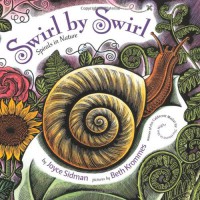Bookworm Blurbs
I absolutely adore reading - my love for books has had a huge impact on my life! I'm going to grad school to be a children's/YA librarian.
Swirl by Swirl: Spirals in Nature

A Caldecott medalist and a Newbery Honor-winning poet celebrate the beauty and value of spirals.What makes the tiny snail shell so beautiful? Why does that shape occur in nature over and over again--in rushing rivers, in a flower bud, even inside your ear?
With simplicity and grace, Krommes and Sidman not only reveal the many spirals in
nature--from fiddleheads to elephant tusks, from crashing waves to spiraling galaxies--
but also celebrate the beauty and usefulness of this fascinating shape. (source)
This is another book that I read for my Resources for Children class, and again, we read this for our class on informative texts. Like Can We Save the Tiger?, Swirl by Swirl is also about nature, but it takes a different approach. Swirl by Swirl serves not to persuade, but to help teach children to appreciate beauty in nature - and I think that it is definitely successful!
As in Can We Save the Tiger?, the illustrations in this book are gorgeous. These ones are more colorful and not quite as realistic - they're meant to be admired. In each picture, different animals are observed forming spirals in some way. I had never realized how many spirals exist in nature, but as it turns out, they're a fairly frequent shape (or are they a pattern...?)! The author points out that spirals are not only pretty, they actually are quite functional and for many animals, they're actually a form of protection.
Some of the students in my class criticized this book for being too abstract. They felt that the concept of looking for otherwise unrelated animals making this specific shape was too bizarre for young children - who are undoubtedly the intended audience for this book - to understand. I personally disagree. I think it may be true that children might not fully grasp the concept, but I think that at the very least they'd enjoy the poetic text and appreciate the beautiful artwork, as well as point out the various animals that they recognize. There is a sort of glossary at the end which goes more in detail about each animal and why they make spirals, so children can access that if they want more information - but I don't know that it's likely that they will.
This isn't a book that would likely be used for a report, but it's one that encourages children to appreciate nature, which I think is important. It's a beautiful book told through thoughtful words and pretty artwork. I think that this would be a nice, calming bedtime book, for those who are reading aloud to their young children.
 4
4 






